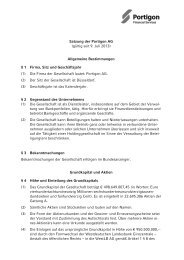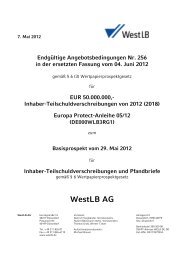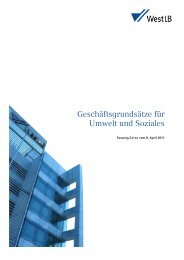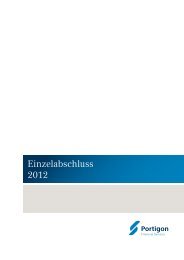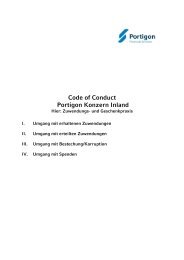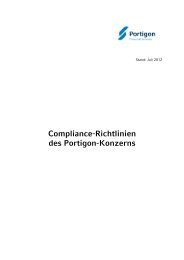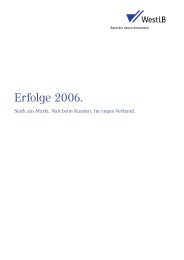pdf, 1996K - WestLB
pdf, 1996K - WestLB
pdf, 1996K - WestLB
You also want an ePaper? Increase the reach of your titles
YUMPU automatically turns print PDFs into web optimized ePapers that Google loves.
RISK FACTORS<br />
The Issuer believes that the following factors may affect its ability to fulfil its obligations under Instruments to be issued<br />
under the Programme. Most of these factors are contingencies which may or may not occur and the Issuer is not in a<br />
position to express a view on the likelihood of any such contingency occurring.<br />
In addition, factors which are material for the purposes of assessing the market risks associated with Instruments to be<br />
issued under the Programme are described below.<br />
The Issuer believes that the factors described below represent the principal risks inherent in investing in Instruments to<br />
be issued under the Programme, but the inability of the Issuer to pay interest, principal or other amounts on or in<br />
connection with any Instruments may occur for other reasons which may not be considered significant risks by the<br />
Issuer based on information currently available to it or which it may not currently be able to anticipate. Prospective<br />
investors should also read the detailed information set out elsewhere in this DIP Prospectus and reach their own views<br />
prior to making any investment decision.<br />
Words and expressions defined in the sections entitled "Terms and Conditions of the Instruments", "Supplemental<br />
Terms and Conditions of the Instruments in Relation to Index Linked Interest Instruments, Equity Linked Interest<br />
Instruments, Index Linked Redemption Instruments or Equity Linked Redemption Instruments" or "Supplemental Terms<br />
and Conditions of the Instruments in relation to Credit Linked Instruments" and commencing on pages 63, 174 and 199,<br />
respectively, shall have the same meanings in this section "Risk Factors".<br />
Factors that May Affect <strong>WestLB</strong>'s Ability to Fulfil Its Obligations under Instruments to Be Issued under the<br />
Programme<br />
The following is a summary of certain aspects of the business of <strong>WestLB</strong> of which prospective investors should be<br />
aware. This summary is not intended to be exhaustive and prospective investors should carefully consider the following<br />
information in conjunction with the other information contained in this DIP Prospectus.<br />
Integrated Bank-wide Risk Steering<br />
The aim of the Issuer's risk management system is to steer the Issuer's risk profile in a proactive manner. The core<br />
processes of risk management are determining, monitoring, analysing, steering and reporting on the Issuer's risks.<br />
The starting point for risk steering is the risk tolerance determined by the Managing Board and owners of the Issuer<br />
using the <strong>WestLB</strong> Capital Adequacy Programme.<br />
The risk tolerance is based on the risk taking capacity. The sources of risk taking capacity are Tier 1 capital,<br />
undisclosed reserves and half of the result forecast for the year. Risk tolerance reflects the scope of risk sought and<br />
limits, as an enterprise-wide value, the amount of risk the Issuer can assume.<br />
The usage of risk tolerance is determined via economic (risk) capital.<br />
Economic risk capital ensures comparability between the various risk categories. The risk capital in each category is<br />
determined for a confidence level of 99.95 per cent., which is in line with a target rating in the A range, and a horizon of<br />
one year. The economic risk capital for counterparty default, participation and market price risks is calculated on the<br />
basis of the value-at-risk (VaR) approach. The Issuer arrives at the figure for bank-wide risk that encompasses all risk<br />
categories by taking the diversification effects between the risk types into account.<br />
The annual budget process, with its integrated risk and return planning, is a cornerstone of bank-wide risk steering.<br />
During budgeting, the business units plan their regulatory and economic risk capital requirements on the basis of the<br />
Issuer's strategy. The determination of these capital requirements is tied to earnings targets, which themselves stem<br />
from the returns the Issuer's owners expect.<br />
ALCO is the committee in charge of allocating risk capital limits. It determines the risk capital limits per risk category<br />
and per organisational unit based on the results of the budget process and on the risk tolerance that has been set.<br />
The Issuer uses additional instruments beyond economic risk capital in order to manage the portfolio's structure,<br />
including specific VaR limits for trading risks and limits for single-name concentrations and industries.<br />
Market Price Risks<br />
Market price risks are the result of uncertainty about price changes and volatility on the financial markets as well as<br />
correlations that exist between different markets.<br />
28



